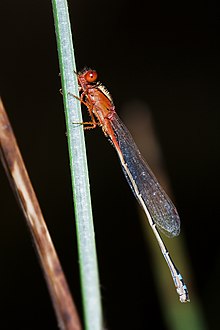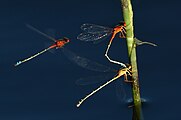Red and blue damsel
Appearance
| Red and blue damsel | |
|---|---|

| |
| Male, Tasmania, Australia | |

| |
| Female | |
| Scientific classification | |
| Domain: | Eukaryota |
| Kingdom: | Animalia |
| Phylum: | Arthropoda |
| Class: | Insecta |
| Order: | Odonata |
| Suborder: | Zygoptera |
| Family: | Coenagrionidae |
| Genus: | Xanthagrion Selys 1876[4] |
| Species: | X. erythroneurum
|
| Binomial name | |
| Xanthagrion erythroneurum | |

| |
The red and blue damsel (Xanthagrion erythroneurum) is a damselfly in the family Coenagrionidae.[5][1] It is the only member of the
Description
The face and
thorax are bright red.[8] The abdomen is pale in colour[8] and 2.2-2.4 cm long.[9] The female and male are similar in colour.[8]
Distribution and habitat
The red and blue damsel is widespread across all Australian states,[9] as well as Fiji, New Caledonia, and other islands in the Pacific.[10] It is found in north and eastern Tasmania. It is typically found near dams, marshes and slow watercourses.[9]
Gallery
-
Mating I. The male holds the female behind her head.
-
Mating II. The male pushes the female under the water.
-
Mating III. The female is completely under the water. Both male and female dragonflies go under.
-
Male
-
Female wings
-
Male wings
References
Wikimedia Commons has media related to Xanthagrion erythroneurum.
Wikispecies has information related to Xanthagrion erythroneurum.
- ^ . Retrieved 20 November 2021.
- ^ "Xanthagrion erythroneurum". ZipcodeZoo.com. July 17, 2009. Archived from the original on June 9, 2012. Retrieved 2009-07-25.
- ^ Selys-Longchamps, E. (1876). "Synopsis des Agrionines (suite du genre Agrion)". Bulletin de la Classe des Science, Académie Royale de Belgique (in French). 42: 490–531, 952–991 [521] – via Biodiversity Heritage Library.
- ^ Selys-Longchamps, E. (1876). "Synopsis des Agrionines (suite du genre Agrion)". Bulletin de la Classe des Science, Académie Royale de Belgique (in French). 42: 490–531, 952–991 [520] – via Biodiversity Heritage Library.
- ^ "Species Xanthagrion erythroneurum (Selys, 1876)". Australian Faunal Directory. Australian Biological Resources Study. 2012. Retrieved 3 April 2017.
- ^ "Genus Xanthagrion Selys, 1876". Australian Faunal Directory. Australian Biological Resources Study. 2012. Retrieved 3 April 2017.
- ^ "Xanthagrion (Genus)". ZipcodeZoo.com. July 17, 2009. Archived from the original on June 9, 2012. Retrieved 2009-07-25.
- ^ a b c "Red and Blue Damselfly - Xanthagrion erythroneurum". Brisbane Insects. Retrieved 2009-07-25.
- ^ a b c Daley, Elizabeth (2007). Wings: An introduction to Tasmania's winged insects. Riffles Pty Ltd.
- ISBN 978-0643051362.







